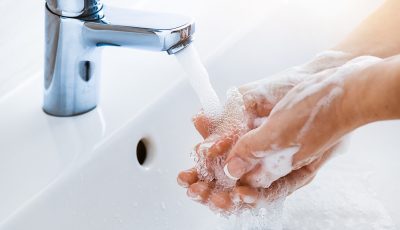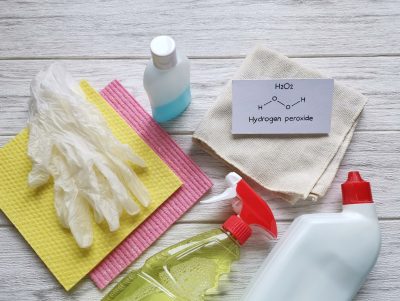In the wake of the newly emerged coronavirus (COVID-19), household cleaners such as isopropyl alcohol, bleach, hydrogen peroxide, and soap have been flying off shelves at supermarkets and drugstores. Now that you’ve stocked up on these items, do you know how to most effectively and efficiently use them? How do we know these cleaners work in the first place?
Combatting COVID-19 with Common Sense Applications

The soap molecules themselves have two ends:
- hydrophilic (“water loving”) – mixes easily with water.
- hydrophobic (“water fearing”) – mixes with fats and oils and repels water.
These two ends make soap particularly well suited to washing away coronavirus, since one of its primary features is its surrounding layer of fat, called an envelope. When the soap and water come into contact with the virus, the hydrophobic ends of the soap molecules wedge themselves into the envelope, disrupting its structure and causing the internal contents of the virus to spill out, destroying it. Meanwhile, the hydrophobic ends allow for everything to be washed away with water.
Isopropyl alcohol is another popular disinfectant, typically found in one of two forms in the home:
- Most pharmacies carry 70% in a plastic bottle near the First Aid Kit section.
- Hand sanitizer produced by Purell, Dial, and other manufacturers.
Both work in the same way by breaking down the 3-dimensional structure of the proteins of the bacteria or virus, rendering them useless.
Other Household Disinfectants to Consider While Safeguarding from COVID-19
Like isopropyl alcohol, hydrogen peroxide (H2O2) has many household cleaning applications. This compound also kills microbes, albeit via a different mechanism. It releases free radicals that wreak havoc on the DNA and other essential components of the germ. Though many microbes have the ability to mitigate damages caused by free radicals, the concentration caused by hydrogen peroxide overwhelms these systems and ultimately kills the germ.
Sodium hypochlorite is the active ingredient in bleach, that works to destroy germs. To date, the Centers for Disease Control and Prevention (CDC) indicates that the exact mechanism for this function has not been fully determined. The current thought is that bleach works in a number of ways to inactivate and destroy germs. From destroying amino acids to preventing the uptake of nutrients by cells and inhibiting the production of new proteins.
More Is Not Always More
When it comes to these disinfecting solutions, the “more is better” adage does not apply. In fact, increasing the concentration of these products makes them less effective at destroying germs and more harmful to the user. Concentrations of isopropyl alcohol higher than the recommended 70% have actually shown to be worse than concentrations below 50% at killing some bacteria. This is due to the higher rate of evaporation and the necessity of water to help the alcohol fully permeate into the cell.
The World Health Organization (WHO) has issued recommendations for concentration of alcohols. Hydrogen peroxide and bleach that have shown to be effective against other enveloped viruses:
- 0.1% (or 1000 parts per million) of bleach diluted in water. The Ontario public health system has a handy calculator for diluting bleach from a household percentage of about 5-6%
- 62-71% alcohol diluted in water. Most of the isopropyl alcohol available at supermarkets and drugstores comes at 70%.
- 0.5% hydrogen peroxide
Other Considerations
While it’s crucial to select the appropriate disinfecting solution when cleaning surfaces, there are many other factors at play. Ensuring that surfaces are already free from obvious dirt and grime that microbes thrive in is essential for guaranteeing their effectiveness.
Wanting to Know More About COVID-19? We’re Here to Help
We are truly living in unprecedented times, as COVID-19 continues its unabated spread throughout the globe. GIOSTAR strives to help our patients cope with this tragic pandemic. We promote a holistic approach that attacks the problem on numerous fronts. We advise patients to be vigilant, using effective cleaning agents, educating themselves about the potential benefits of stem cells on COVID-19, and keeping in regular communication with their physician.
Please contact us by completing a brief online form, emailing us (info@giostarchicago.com), or calling us ((844) 446 7827). Our patient outreach team would be happy to discuss your options for improving your overall health and wellness.


